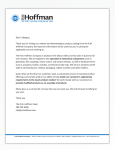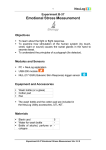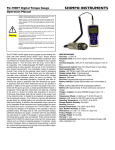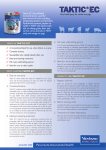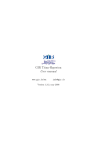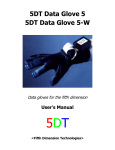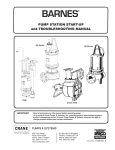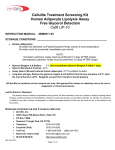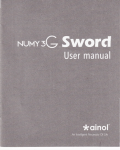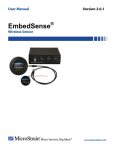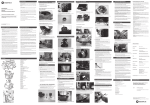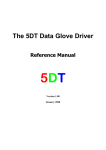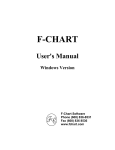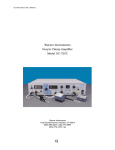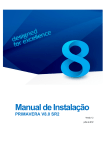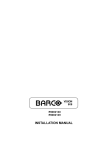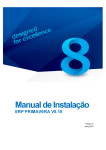Download Perfusion Fast-Step User`s Manual
Transcript
Perfusion Fast -Step Model SF-77B Publication 5707-001-REV-A WEEE/RoHS Compliance Statement EU Directives WEEE and RoHS To Our Valued Customers: We are committed to being a good corporate citizen. As part of that commitment, we strive to maintain an environmentally conscious manufacturing operation. The European Union (EU) has enacted two Directives, the first on product recycling (Waste Electrical and Electronic Equipment, WEEE) and the second limiting the use of certain substances (Restriction on the use of Hazardous Substances, RoHS). Over time, these Directives will be implemented in the national laws of each EU Member State. Once the final national regulations have been put into place, recycling will be offered for our products which are within the scope of the WEEE Directive. Products falling under the scope of the WEEE Directive available for sale after August 13, 2005 will be identified with a “wheelie bin” symbol. Two Categories of products covered by the WEEE Directive are currently exempt from the RoHS Directive – Category 8, medical devices (with the exception of implanted or infected products) and Category 9, monitoring and control instruments. Most of our products fall into either Category 8 or 9 and are currently exempt from the RoHS Directive. We will continue to monitor the application of the RoHS Directive to its products and will comply with any changes as they apply. • Do Not Dispose Product with Municipal Waste • Special Collection/Disposal Required Table of Contents Warner Instruments Perfusion Fast-Step Model SF-77B 1 SUBJECT PAGE Introduction ..........................................................................2-3 Front Panel Description ..........................................................4 Rear Panel Description ............................................................5 System Description..................................................................6 Set-up Procedure......................................................................7 Capillary Tubes and Holder ....................................7-8 Manifolds ....................................................................8 Mounting the Motor Assembly ..............................9-10 Loading Solutions ................................................10-11 Care And Maintenance ............................................11 Using the Controller ............................................12-13 Fast Stepping with Theta Glass ..............................13 Sample Experiment ..........................................................14-15 Specifications ....................................................................16-17 Accessory Reorders ..............................................................18 Warranty & Services ..............................................................19 www.warneronline.com Introduction Warner Instruments Perfusion Fast-Step Model SF-77B 2 The SF-77B is a simple but highly effective stimulus solution delivery device for use in a variety of patch clamp and electrophysiology studies. Control and test solutions flow continuously through adjacent stimulus delivery tubes and a stepper mechanism selects which tube is directed at the preparation. The rapid response and nominal hysteresis of the stepper mechanism allows for very fast switching times. Complete solution changes are typically achieved within 20 msec for a large 700 mm step and times are significantly shortened as the step size is decreased. Multiple Solution Studies In the standard configuration, up to six different solutions are connected to a single input manifold which in turn is connected to one of three square glass stimulus ports. The three stimulus port design is superior to a two-port design in that complex solution exchange protocols can be brought to bear on the sample under study. Since the complete system is designed o accommodate three manifolds (one for each stimulus port) and each manifold can accommodate up to 6 feed lines, it is possible to immediately select between 18 different input solutions. • Solution changes between stimulus ports occur within milliseconds. • Changes between solutions connected to an individual port occur within five seconds. • Entirely new solutions can be added into any port with a waiting time of no more than 30 seconds. • The cell is never required to pass through intervening solutions to get from control to test solution. Manual or External Control The stepper mechanism can be manually controlled via the front panel or externally directed from your data acquisition program. Manually, the system can be stepped to 8 positions in 7 equally spaced steps. These same 8 positions can also be directly selected by applying an analog signal to the external analog input BNC or by passing a 3 byte word to the TTL input on the instrument rear panel. Square Glass Stimulus Ports The square glass tubes used for solution delivery significantly reduces mixing turbulence between solutions allowing the SF-77B to be used for studies with both membrane patches and whole cells, even when the cells are not fixed to a substrate. Publication 5707-001-REV-A www.warneronline.com Introduction (Cont’d) Warner Instruments Perfusion Fast-Step Model SF-77B 3 System Versatility The design of the SF-77B permits the use of various size glass tubing for perfusion delivery. SF-77B – Standard System (0.7 mm ID tubes) The standard system is shipped with 3SG700-5 single-walled 3-barrel glass tubing which eliminates the need to glue individual barrels together. Spacing between barrels is 0.7 mm and step speed between adjacent barrels is typically 20 msec. Single barrel SG800-5 tubes (up to 5) can be used with the same holder. SF-77BLT – Large Tube System (1.0 mm ID tubes) Larger stimulus ports are required when using the SF-77B with larger cell structures such as the Xenopus oocyte. Solutions are delivered through 1.0 mm ID square tubes (SG1000-5) with barrel-to-barrel spacing of 1.4 mm. SF-77BST – 1 msec Stepping with Theta Tubing The SF-77B has been successfully tested using theta style capillary tubing with a step speed of 1 msec between adjacent barrels. Standard 2 mm diameter theta tubing is pulled to a tip diameter of 300 mm with a spacing of 100 mm between barrels. In this design, placement of the pipette tip is critical due to the smaller perfusion stream. Since mechanical artifacts can be evident when using these small step sizes the motor drive voltage is adjustable at the rear panel. Easy Set-Up The stepper mechanism is compact, lightweight, and free of either mechanical or electrical noise.The mechanism connects to the control box with a 2 meter shielded cable and is provided with a mounting rod for attachment to a manipulator. Manifolds can support 2,4 or 6 inputs depending on the experiment. Solutions flow from reservoirs to the manifold Solutions B1-B6 Solutions C1-C6 through PE-50 Solutions A1-A6 Approximately 30 seconds tubing and PE-50 Tubings for new solution flow when adding new reservoirs. PE-10 tubing is Manifold B Manifold C Manifold A used to connect the manifold outputs to Approximately 5 seconds PE-10 Tubings for new solution flow when switching manifold input. the glass tubes. Glass Tubes Step Stimulus effect in 20 milliseconds for 800 µm step size Cell attached electrode Step Publication 5707-001-REV-A www.warneronline.com Front Panel Description Warner Instruments Perfusion Fast-Step Model SF-77B 4 E D A) STEPS/POSITION A C B Step length (distance between stepper positions) is selected with the thumbwheel control. Minimum step size is 100 µm (.004 inches) with the thumbwheel set at 1 and the maximum step is 1.5 mm (.060 inches) with the control at 15.When using the 3 barrel glass supplied with the standard SF-77B (p/n 3GC700-5, barrel to barrel spacing of 700 µm), the control is set to 7 (7 x 100 µm). B) MODE SELECT SWITCH Control of the stepper device can be INTERNAL (manual), EXT DIGITAL or EXT ANALOG. The 3 position toggle switch is used to select the desired mode. C) INTERNAL A 5-position switch is used to manually select up to 5 positions.An LED display indicates the position selected. This same display indicates position when control is from an external signal. EXT DIGITAL See rear panel description for controlling with a digital signal. D) EXT ANALOG An analog signal for stepper control is applied to this input. Up to 5 positions can be used. Positions correspond to the dc voltage levels as shown: Position 0 0 volts Position 3 3 volts Position 1 1 volt Position 4 4 volts Position 2 2 volts E) INITIALIZE The INITIALIZE push-button is used to initialize the pipe position at the beginning of an experiment or at any time one wishes to check or confirm positions. This is done in the INTERNAL (manual) mode by selecting the desired position and depressing the push-button. Publication 5707-001-REV-A www.warneronline.com Rear Panel Description H Warner Instruments Perfusion Fast-Step Model SF-77B 5 J F G F) POWER BLOCK This block includes the power line cord connector, ON-OFF switch and the input power fuse. G) MOTOR The stepper mechanism connects to the control box here. H) EXTERNAL DIGITAL INPUT Digital inputs for position control connect to the 3 BNC connectors labeled D0, D1 and D2. Up to 8 positions can be controlled when all 3 lines are used. Digital inputs are TTL compatible and readily accept digital outputs from computers and computer interfaces. Positions are controlled per the table shown here. TRUTH TABLE Position D0 D1 D2 0 L L L 1 H L L 2 L H L 3 H H L 4 L L H 5 H L H 6 L H H 7 H H H J) MOTOR VOLTAGE ADJUST This control is factory set and only used for experiments involving small (100 µm) steps. Its use is further described in the section dealing with Fast Stepping with Theta Tubing. Publication 5707-001-REV-A www.warneronline.com System Description Warner Instruments Perfusion Fast-Step Model SF-77B 6 The main use of the SF-77B Perfusion Fast - Step is the rapid change of solutions bathing a single cell or patch of membrane attached to a patch electrode. Solution changes can be made in as little as 20-50 ms (approximately 1 ms using 2 barrel Theta tubing) and once changed the new solution with its particular concentration of pharmacological agent will remain stable until changed again. An important capability of this device is also that a large number of solutions can be utilized during the course of a single experiment, in spite of the compact size of the device. This takes a bit of organizational thought before starting the experiment, but the return is the ability to easily use 1530 different solutions in a single experiment. This is accomplished by having as many as six solutions feeding through a unique manifold into each of the three "pipes" in front of which the cell may be placed. This allows any of the three pipes to have any one of 6 solutions flowing through it at any time. It is even possible, during the course of an experiment, to change the six solutions flowing into any one of the manifolds, allowing a virtually limitless number of solutions to be used. In order to fully implement this feature it is important to realize that there are actually three time frames that need to be considered in the proper use of the device. The first is the 50 ms or less time course for changing between different pipes. The second is the 5 second dead time required to change from one solution to another in the same pipe. Finally there is the 30-60 second time required to change one of the six starting solutions flowing into any of the three manifolds. The third time frame is only important for experiments that would typically use more than 15 different solutions in a single experiment. Each of these uses will be explained in detail, and a "typical" experiment will be worked through using each of these features. Publication 5707-001-REV-A www.warneronline.com Set-Up Procedure 7 Warner Instruments Perfusion Fast-Step Model SF-77B The SF-77B Perfusion Fast - Step systems are packaged in three parts: 1) stepper motor assembly with a set of 3 manifolds*; 2) the electronic controller; 3) glass holder, the capillary tubes and polyeyhylene tubing. * MM Series are supplied with SF-77B and SF-77BST. ML Series are supplied with SF-77BLT. Manifolds are available in 2, 4, and 6 inputs. T h e C a p i l l a r y T u be s a n d H o l d e r Glass Capillaries The SF-77 B Perfusion Fast - Step makes use of square capillary tubes for its "pipes". These facilitate placement of the tubes in the chamber and, more importantly, reduce turbulence and provide a more even flow of solution. The capillaries supplied with the standard SF-77Bare 3-barrel which have an inside dimension of 0.6 mm each barrel and a wall of 0.1 mm. The barrels have been fused together in manufacture so no gluing is necessary. Larger 1.0 mm tubing is supplied with system SF-77BLT and 2-barrel Theta tubing is supplied with the SF-77BST. Glass Holders The appropriate glass holder is supplied with each system. The standard SF-77B holder is the GH-1. It holds the 3SG700-5 three-barrel tubing or up to 5 individual barrels of SG800-5 tubing (0.6 mm inside, 0.12 mm wall). SF-77BLT is supplied with the GH-10 holder which holds up to 3 of the SG1000-5 glass tubes (1.0 mm inside, 0.2 mm wall). Holder GH-2T holds the 2 mm Theta glass. Holding the Glass The capillaries can be mounted directly in the holder, which maintains them in position by pressure. The 3-barrel glass is simply placed into the holder slot and the threaded handle is tightened to hold the glass rigid. If single tubes are used, we recommend that the capillaries be cemented together first to insure that they are perfectly level and in alignment. Place the capillaries on a flat surface and butt the ends against a straight edge. Alignment is critical. We suggest you check under a dissecting microscope. Use only a small dab of cement placed near, but not exactly at the center line in the lengthwise direction. Do not put the cement near either end of the tubes as capillary action will carry it into the tubes and may clog them. Publication 5707-001-REV-A www.warneronline.com Set-Up Procedure (Cont’d) Warner Instruments Perfusion Fast-Step Model SF-77B 8 After the cement dries (a few minutes is sufficient) simply slide the tubes into the holder such that nearly half of the tube length extends from the holder. This length is adjustable depending on the dimensions of your particular set-up and chamber. Ideally, however, it is best to have the tubes more or less centered on the holder. The tubes and holder can be attached easily to the mounting device, but this should be done after this device is installed, as described in the next section. M a n i f o l ds Manifolds are made with 2, 4, and 6 inputs (specified at time of order). MM Series manifolds are standard with the SF-77B and SF-77BST. ML Series are provided with the SF-77BLT. MM Series Manifolds The inputs connect to PE-50 tubing which fits over the hypodermic tubings. A length of PE-10 tubing is factory installed in the manifold output. This tubing fits into the glass pipes and is sealed with wax. At some time in the future, the PE-10 tubing will require replacement. Proceed as follows: 1) Unscrew the manifold tail from the head and pull the old tubing from the tail. 2) Cut a length of PE-10 tubing, 8 to 9 inches long. 3) You need to stretch one end of the tubing so that its diameter is reduced sufficiently to fit into the hole in the tail piece. Do this by gripping one end between thumb and forefinger of both hands and pulling firmly. This may take a little practice. 4) Trim off the unstretched portion of tubing at the end so that the smaller diameter portion can be inserted into the hole. Pull the tubing through until the full diameter is inside the tail. Trim the tubing flush with the tail inside end and reinstall in the head piece. Make sure the rubber seal is inside the head before screwing the parts together. ML Series Manifolds These manifolds use the PE-50 tubing on both input and output. The larger PE-50 fits nicely into the SG1000-5 glass pipes used with the SF-77BLT. Publication 5707-001-REV-A www.warneronline.com Set-Up Procedure (Cont’d) 9 Warner Instruments Perfusion Fast-Step Model SF-77B M o u n t i n g t h e M o t o r A s s e m bl y The SF-77B Perfusion Fast - Step is designed to be mounted on and positioned by a manipulator. It is light enough to be attached to a micromanipulator without producing drift, but for most applications a standard coarse manipulator will be sufficient. Ideally the device should be positioned within the set-up so that it can be easily removed from the manipulator and replaced. This will facilitate cleaning and loading the device. Positioning the angle of the motor assembly is made by loosening the black wing nut. When loosened, the motor mount bracket and manifold bar can be rotated to accomodate the setup. Additionally, the angle of the motor extension bar (white plastic bar attached to the motor drive) can be adjusted by rotating the motor collar (black block mounted on the motor). Before rotating the block, loosen the small set screw with the Allen wrench supplied with the SF-77B motor assembly. Retighten the screw lightly once the desired position is attained. NOTE: Do not overtighten this screw. Motor operation may be adversely effected. A subsection of this part of the device is the assembly of tubing etc. that will feed solutions into the manifolds and then to the pipes. Most simply, the feeder arrangement consists of up to 18 syringes with luer stopcocks (ideally 2-way to minimize; three-way can be used, however this tends to introduce air bubbles at the point of entry into the PE-50 tubing. Be careful to avoid air bubbles, as once in the PE-tubing, the flow of solution is inhibited. Depending on the rate of flow used for a particular application, this may not be detected immediately. Avoidance and removal of bubbles will be discussed later). The syringes are mounted in a rack, loading end up, and placed approximately 1 meter above the surface on which the chamber is fastened (usually the microscope stage). The height above the device will depend on the experimental design, for example, perfusing an inside out patch will require a slower flow rate than perfusing a cell. The syringes can be mounted either inside or outside of the Faraday cage if one is being used. A distinct advantage to this system is that electrical noise is not a problem, even for single channel recording. Syringes of 20 or 60 ml volume are recommended, although other containers such as seperatory funnels or bottles can be used. The main advantage of syringes is their economy and disposability. For expensive reagents smaller syringes can be used. With careful preparation of the Publication 5707-001-REV-A www.warneronline.com Set-Up Procedure (Cont’d) Warner Instruments Perfusion Fast-Step Model SF-77B 10 solution feeder lines, the SF-77B Perfusion Fast - Step can be reliably used with less than 1 ml of solution in the reservoir and with less than 0.5 ml to prime the line (depending on distance of solution reservoir from the microscope stage). L o a di n g S o l u t i o n s It is recommended that one of the solutions in each of the three pipes should be the control buffer bathing the cells or patches. This solution can be used as a rinsing solution between applications. Solutions are poured into the syringes with the luer stopcock set to the closed position. A useful method for the removal of air bubbles is as follows. Remove the tip of a cotton tipped applicator and pack into the needle, this acts as a bubble trap. Even with careful removal of air bubbles prior to the solution reaching the PE-tubing, occasionally small bubbles will form. The cotton tip breaks up the bubble, then the smaller ones formed can be easily tapped out. To prevent bubble formation in the bulk of the solution, always pre-warm solutions. This entire procedure is made much easier by removing the manifold from the holding bar and unscrewing the tail portion of the manifold, that is the section of the manifold through which solutions flow out and into the capillary. Because the output tubing is so much smaller than the input tubes the resistance is considerable and this can cause solution to back up into neighboring tubes during the filling procedure. Without the output section of the manifold this does not occur. After all the lines are filled the manifold can be screwed together again and mounted back in the holder. Next, remove the needle from the syringe. Hold the needle about 1-2 mm below the syringe, then open the luer valve. Solution will flow under the force of gravity, without the requirement for additional force, for example by plunging the syringe. As soon as the solution reaches the end, allow a small drop of solution to enter the needle. When the cotton is wet, quickly insert the needle on the syringe. Observe the solution passing along the PE-50 tubing, then after making sure that there are no columns of air in the tubing, switch the luer valve to closed. Inspect the needle to see if any air bubbles are present, tap the needle to dislodge. Often large bubbles will form at the junction of the syringe and the luer valve, these can be easily removed by tapping. If this will not suffice, then insert a long needle into the solution and draw out the air bubble (care must be taken not to cross contaminate). If at this point even a small bubble remains, tap the syringe and dislodge. This can be rather time consuming, depending on the number of solutions to be used, but is a very useful exercise that will maximise the performance of the SF-77 Perfusion Fast - Step. Publication 5707-001-REV-A www.warneronline.com Set-Up Procedure (Cont’d) Perfusion Fast-Step Model SF-77B Next attach the PE-50 tubing to the mainfold. Open the luer valve and allow solution to flow through the glass ‘pipes’. If at this point there is inhibition of solution flow into the glass ‘pipe’, turn the luer valve to closed and remove the outflowing section of the mainfold. Insert into a piece of tygon tubing (I.D. 1/16, O.D. 1/8 Wall 1/32) attached to a syringe, and simply aspirate and eject air. Re-attach the manifold and open the luer valve. If there is no solution flow at this point apply positive pressure to the reservoir syringe (making sure all other feeder lines are closed otherwise backflow will occur. The luer valve should be briefly re-opened to be sure that solution is indeed flowing through the line. The same procedure is repeated for each solution in turn. After all six solutions have been readied in this way it is advisable to turn on the buffer solution line so as to clean the capillary pipe of any residual solutions. Warner Instruments 11 The same procedure should be repeated for each of the three capillary pipes. When completed all the solutions to be used in the experiment are at the manifold so that simply turning a stopcock to the on position will allow that solution to flow from the manifold to the capillary tube. This should require less than 2 seconds, but 5 seconds are recommended to be sure that the last solutions have been completely washed out. Although in general there is no leakage from the end of the pipes we recommend that at the start of an experiment all three pipes have buffer flowing through them (see sample Experiment below). If a line is not to be used (i.e. if less than six solutions are to be used in any one pipe) then it is necessary to use a "plug" for that line on the manifold. This is to prevent solution from "backing up" into an open line. Alternatively all unused lines can simply be loaded with buffer solution, however this is more time consuming. NOTE: It is best to keep the output ends of the pipes submerged in solution or water when changing the setup. If the pipes are left unsubmerged for any length of time, fluid will weep from the tubings and air bubbles will creep in. Ca r e a n d M a i n t e n a n c e At the end of each experiment, allow all solutions to flow out of the reservoir and add a few ml of 70% ethanol. The manifold is composed of delrin and stainless steel and PE-tubing is unaffected by ethanol, thus this cleaning procedure can be withstood. Next flush all the lines with water. After all solutions have run through, remove the needle and dispose of the cotton tip (prevent cross contamination of solutions). Finally air dry (pressurized) solution lines. Publication 5707-001-REV-A www.warneronline.com Set-Up Procedure (Cont’d) 12 Warner Instruments Perfusion Fast-Step Model SF-77B U s i n g t h e Co n t r o l l e r Control of the SF-77B Perfusion Fast - Step has been designed to be as simple as possible. The device can be controlled manually or by electronic signals generated by a computer or stimulator. The three main parameters under the investigators control are position, step size and duration. Position tells the device which capillary pipe to position in front of the target cell or membrane patch. Step size, adjustable from 0.1mm to 1.5mm in 0.1mm steps, is selected for the center to center distance of the pipes. Duration determines the length of time that the capillary pipes remain in a given position. Position. There are five available positions in INTERNAL (manual) and EXT ANALOG modes and eight positions in the EXT DIGITAL mode. The typical use is with 3 pipes and only three positions are required. Position is selected by manual switch position or by an external analog or digital signal.The position selected is displayed on the LED readout. Analog Voltage Control When using an analog input, the positions are voltage sensitive. Zero volts corresponds to 0 position and stepping the voltage in 1 volt increments steps the device (2 volts = position 2, etc.). Digital Control The rear panel has 3 BNC inputs to accept standard TTL compatible signals for digital control from a computer or other digital signal source. The 3 inputs allow for as many as 8 positions to be controlled. See REAR PANEL DESCRIPTION (section 2.0) for more detail. Step Size. The distance traveled is adjusted with the counter control (steps/position). Minimum step is 0.1mm (1 step) and maximum is 1.5mm (15 steps). For the standard 3SG700-5 capillary pipes supplied (barrel to barel spacing 0.7 mm), a step length of 7 is required to move from center to center. This adjustment should, however, be made empirically for each new set of capillary pipes. Duration. When driven with an analog signal, the time spent in a position is determined simply by how long the voltage corresponding to that position lasts. To move from pipe 0 to pipe 1 for 1 second and then return to pipe 0 requires a voltage step of from 0 to 1 V that lasts 1 second and then returns to 0 V. I If a digital signal is the external control, the stepper will stay in a position until it receives the next command. In the absence of a signal, the motor will go to the “0” position. Manually, the position is maintained until changed to another switch position. Publication 5707-001-REV-A www.warneronline.com Set-Up Procedure (Cont’d) Warner Instruments Perfusion Fast-Step Model SF-77B 13 Initializing the Position Before beginning any experiment it is required to initialize the pipe position by pressing the "Initialize" button. The stepper motor will move to whichever position is manually selected. This brings the pipes into a known position from which all other positions are referenced. For a setup with 3 pipes, initialize in the center position "2". Readjust the flexture spring holder to correct the alignment if necessary (loosen the collar set screw and move the collar to align the flexture spring to its neutral unflexed position). External Control - If the initialization is performed when there is 0 volts on the input line then the pipes will automatically assume the 0 position. If there is another voltage on the line then the pipes will go to that position immediately, and automatically, after the initialization. If at any time during an experiment or series of experiments the positions become confused then simply pushing the initialize button will bring everything back into register. F a s t S t e pp i n g w i t h T h e t a G l a s s Very fast perfusion stepping is possible using 2 barrel Theta tubing. The technique requires close attention to detail and careful placing of the pipes and the excised patch. The following is information provided as a general guide. Preparation of the Theta Glass The tubing is pulled on a standard puller for a tip diameter of approximately 300 µm and a barrel to barrel spacing of approximately 100 µm. Motor Voltage Adjustment When using 100 µm steps, it is important to minimize any vibration produced by the stepper motor. This is accomplished by reducing the motor voltage with the control located on the rear panel. The voltage is lowered until the vibration artifact is minimized. Any residual artifact may be removed by subtracting averaged null traces. Reference: Jie Zheng and Fred Sigworth, Selecting Changes during Activation of Mutant Shaker Potassium Channels, J. General Physiology, vol.10 August 1997, 101-117 Rockefeller Univ. Press Publication 5707-001-REV-A www.warneronline.com Sample Experiment Warner Instruments Perfusion Fast-Step Model SF-77B 14 As an example of the use of this stimulating system we may take an experiment in which the activity of several adrenergic agonists and antagonists are investigated for their ability to modulate a K-current in Pancreatic islet ß cells. Prior to beginning the experiment the reservoirs feeding the three pipes (we will call them 0, 1 and 2) are mounted approximately 1 meter above the microscope stage. They do not have to be placed inside the Faraday cage. For each pipe one of the six lines will contain physiological buffer, i.e. the control bathing solution. Pipe 0 will also have an adrenergic agonist, clonidine, at 5 concentrations from 1 nM to 1 µM. Pipe 2 will have the antagonist yohimbine, also at 5 concentrations. Pipe 1 will have epinephrine at 5 concentrations. Thus each pipe has buffer and either an agonist or antagonist at 5 different concentrations. After each of the solutions is brought into the manifold and through the pipes, the buffer is turned on in each pipe to completely wash away the other solutions. Thus at the beginning of the experiment each of three pipes has only buffer in it. All solutions are turned off so that nothing is leaking from the pipes. Finally the position of the pipes is initialized. After a cell is chosen and the whole cell patch clamp configuration obtained the stimulating apparatus is lowered into the dish, and under low power is manipulated into the region of the cell. Depending on the preparation the cell may either remain attached to the dish substrate or may be suspended above the floor of the dish on the tip of the electrode. In either case the pipes are manipulated into a position in which the cell is directly opposite the lumen of pipe 0. Buffer is turned on in all three pipes so that the cell is now in a flowing solution of control physiological buffer. A series of 5 membrane voltage pulses each lasting 50 ms are delivered to determine the magnitude of the K-current under control conditions. Following this, the solution in pipe 1 is switched to the lowest concentration of epinephrine. A stimulating protocol in which the cell is moved to pipe 1 (by delivering a 1 volt step from the analog output) immediately after which a series of membrane voltage steps lasting 50 ms each are delivered, and then the cell is returned to pipe 0 (by changing to 0 volts from the output). The duration of the step is 300 ms (5 x 50 ms, with a 10 ms delay between each membrane voltage step). The data are saved and the solution in pipe 0 is changed to the next highest concentration of epinephrine by turning one luer stopcock to the off position and the next one to the on position. 5 seconds later the same protocol can be repeated, now examining the effect of the higher concentration of epinephrine on the Kcurrent elicited by voltage. After the series of 5 concentrations of epinephrine are completed the pipes are shifted so that the cell is now in the lumen of Pipe 1, which has Publication 5707-001-REV-A www.warneronline.com Sample Experiment (Cont’d) Warner Instruments Perfusion Fast-Step Model SF-77B 15 been changed to buffer. This is accomplished by having 1 volt appear on the output. The same experiment can now be repeated with different concentrations of clonidine as the pipes are moved so that the cell goes from pipe 1 to pipe 0. The only change in the stimulus protocol is that the voltage output goes from 1 to 0 and back to 1 for each test series. Upon completion of the agonist series the antagonist effects can be tested. First the lowest concentration of Yohimbine is turned on in pipe 2 and the cell is moved to that pipe (i.e. the pipes are shifted so that the cell is in front of this pipe). An effective concentration of epinephrine (determined from the earlier run) is now turned on in pipe 1. For this experiment the cell is shifted from pipe 2 to pipe 1, but possibly for only a single 50 ms voltage pulse so that the antagonist cannot be competed off by the agonist. Thus the protocol is for the analog output to go from 2 volts to 1 volt and back to 2 volts in about 90 ms. Once in the agonist solution (change time is about 30 ms) the voltage pulse is delivered to evoke the K-current, and the cell is immediately moved back to pipe 2. This can be repeated for the 5 concentrations of antagonist available to pipe 2. For this experiment all of the protocols could have been written previously, requiring only a new protocol to be brought up, one or two luer stopcocks to be turned on or off and a button to be pushed activating the computer acquisition. The total estimated time of such an experiment could be as little as 4-5 minutes. In the course of this relatively straightforward experiment 15 concentrations of 3 pharmacological agents have been tested for their effects on the K-current. These data should provide relatively complete dose response data for these three agents, and by the simple process of changing the duration of the steps into the stimulus solutions (by simply lengthening the voltage output) kinetic data could also be obtained. If the effective concentrations for these drugs had already been known a smaller range of concentrations could have been used and additional drugs included in the experiment. New reservoirs could also be installed with new drugs, extending the time of the experiment only an additional 10 or so minutes. More complex stimulus protocols are also possible in which there are several shifts of the pipes during the course of a single test. Thus it would be possible to go from pipe 0 to pipe 1 for a period of time and then to pipe 2, returning either to pipe 1 or pipe 0. The stay in each pipe is independently variable. It is also important to note that, in the case of electrophysiological experiments, membrane potential may be varied independently of the pipe movement.Thus this simple arrangement allows the experimenter the flexibility to build quite complex stimulus parameters. Publication 5707-001-REV-A www.warneronline.com Specifications Warner Instruments Perfusion Fast-Step Model SF-77B 16 Specifications Number of Steps: 1 to 7 (2 to 8 positions) Step Size: Adjustable from 100 µ m to 1.5 mm in 100 µ m increments, with STEPS/POSITION switch Step Speed: Typically 20 msec for a 700 µ m step Step Control: Manual: 8 position with POSITION selector Analog Signal: 5 positions with voltage levels 0-4 Volts, 1V/step Digital Signal: Maximum Stepped Range: 8 positions with 3 byte TTL signal 12.5 mm Mounting Handle: 6.3 mm dia. X 10 cm long Stepper Weight: (including handle) 110.5 grams Solution Manifolds Three manifolds are supplied with each system; MM series for SF-77B and SF-77BST and ML series with SF-77BLT. Manifolds have 2,4 or 6 inputs. Specify your choice when ordering. MM Series: MM-2, MM-4 and MM-6 manifolds use PE-50 tubing at the input and PE-10 tubing at output ML Series: ML-2, ML-4 and ML-6 manifolds use PE-50 tubing at both input and output Solution Flow Rates With MM Series: 100 µ l/min With ML Series: 1 ml/min Rates are measured with a solution reservoir height of approximately 60 cm (24 inches). Control Box Size: 6.3 cm H x 14 cm W x 23 cm D Power Requirements: 100-130 or 220-250 VAC, 50/60 Hz, 10 VA System Shipping Weight: 2.7 kg Warranty: 2 years, parts and labor Publication 5707-001-REV-A www.warneronline.com Specifications (Cont’d) Glass Tubes (end views) SG800-5 3SG700-5 SG1000-5 TGC200-10 .84 1.4 1.4 .6 1.0 2 2.5 .7 ALL DIMENSIONS IN MILLIMETERS Warner Instruments Perfusion Fast-Step Model SF-77B 17 Publication 5707-001-REV-A www.warneronline.com Accessory Reorders Warner Instruments Perfusion Fast-Step Model SF-77B 18 Business hours are 8:30 AM to 5:00 PM (eastern time), Monday to Friday. Telephone: 800-599-4203 Fax: 203-776-1278 The following accessories are available from stock: Order No. Description Pkg. Qty. 64-0200 Manifold, 2 to 1 1 64-0201 Manifold, 4 to 1 1 64-0202 Manifold, 6 to 1 1 64-0203 Manifold, 2 to 1 1 64-0204 Manifold, 4 to 1 1 64-0205 Manifold, 6 to 1 1 64-0750 Polyethylene Tubing 10’ 64-0752 Polyethylene Tubing 10’ 64-0119 3-Barrel Square Glass Tubes, 0.6 mm ID, 5 cm long 10 64-0120 3-Barrel Square Glass Tubes, 0.6 mm ID, 10 cm long 10 64-0121 Single Barrel Square Glass Tubes, 0.6 mm ID, 0.84 mm OD, 5 cm long 25 64-0122 Single Barrel Square Glass Tubes, 1 mm ID, 1.4 mm OD, 5 cm long 25 64-0811 Theta Glass Tubes, 2.0 mm OD, 10 cm long 100 64-0124 Glass Holder for 3SG700-5 or SG800-5 Glass 1 64-0125 Glass Holder for 2 mm Theta Glass 1 64-0126 Glass Holder for SG1000-5 Glass 1 Other sizes of square glass tubing are available from: Vitrocom, Inc. Mountain Lakes, New Jersey 07046 Telephone: 201-402-1443. Publication 5707-001-REV-A www.warneronline.com Warranty & Services Please direct your questions regarding service or repairs to our engineering department at 800-599-4203. Warner Instrument Corp. warrants the model SF-77B Perfusion Fast-Step system to be free from defects in materials and workmanship for a period of 2 years from date of shipment. If a failure occurs within this period, we will either repair or replace, at our option, the faulty component(s). Warner Instruments Perfusion Fast-Step Model SF-77B 19 Publication 5707-001-REV-A www.warneronline.com





















